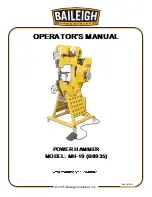
8 Basic CNC Programming
8.4 NC Codes
127
8.4.18.
S Code: Spindle Speed
Use the S code to set the spindle speed from within the NC program. Spindle speed is specified by the
address character “S” followed by a parameter that represents the speed in RPM. For example, S750 is
the designation for a spindle speed of 750 RPM.
If the spindle is off when the S code is used, the spindle speed is stored and used when the spindle is
turned on again within the program by the M03 command.
8.4.19.
T Code: Tool Selection
A T code is used to specify the tool (by number) from the tool ATC to be used for an operation. Tools are
specified by the address character “T” followed by a parameter that represents the number of the tool.
For example, T3 is the designation for tool number three.
Safety
Using multiple tools is an advanced operation and should not be attempted by persons
unfamiliar with using the ProMill 8000 milling center.
10 Multiple Tool Programming, pg. 145.
8.4.20.
X and U Codes: X Axis Coordinate
An X code specifies the coordinate of the destination along the X axis. A U code is used in absolute
programming mode (G90) to specify an incremental X motion. You cannot use the U code to mix
incremental and absolute programming in the same block.
8.4.21.
Y and V Codes: Y Axis Coordinate
A Y code specifies the coordinate of the destination along the Y axis. A V code is used in absolute
programming mode (G90) to specify an incremental Y motion. You cannot use the V code to mix
incremental and absolute programming in the same block.
8.4.22.
Z and W Codes: Z Axis Coordinate
The Z code specifies the coordinate of the destination along the Z axis (spindle axis). A W code is used in
absolute programming mode (G90) to specify an incremental Z motion. You cannot use the W code to
mix incremental and absolute programming in the same block.
8.4.23.
Comment Codes
The control software allows you to add comments (notes) to your NC code lines. The control software
recognizes two comment codes, a semicolon ; and an open parenthesis (. These two comment codes are
equivalent. The use of either of these codes within an NC block indicates that a comment follows.
Comments must follow all other NC codes in the block. Comments are ignored when the part program is
executed. Comments can be placed on a block without any NC codes.
















































